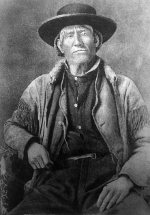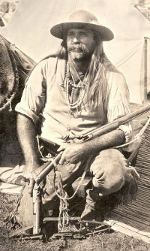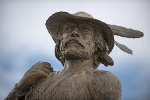Jim Bridger: Famous Mountain Man and Guide
Jim Bridger was one of 19th Century America's most famous Mountain Men. A strongly built and exceedingly healthy man, he also had a very good memory and an ability to talk his way out of trouble. This combination led to his reputation as a successful trapper and wilderness guide. He made large contributions to the North American fur trade. 
Bridger was born on March 17, 1804, in Richmond, Va. His father was an innkeeper and jack-of-all-trades who after time found it hard to get a job and so moved the family to what was then a relatively new state, Illinois, to Six Mile Prairie, not far from St. Louis. Young Jim was a fan of watching boats go up and down the Mississippi River. He suffered through three deaths in the family in quick succession. His mother died when he was 12, his older brother died soon afterward, and then his father died the following year; that left Jim and his sister as the only members of the family. The teenage Bridger took a job operating a ferry and then moved to St. Louis, where he found work as an apprentice at a blacksmith shop. It was in 1822 that his career choice and life changed for good. An ad in the St. Louis Intelligencer from the famous William H. Ashley requested men with an adventurous bent to come along and work on the burgeoning fur trade. Bridger, who never learned to read, found out the details and applied. He was accepted and, at 18, was the youngest who made the journey out west, along with other famous Mountain Men, including Hugh Glass, Thomas Fitzpatrick, and Jedediah Smith. He became famous for his ability to remember geographical features, and subsequent expeditions benefited from his encyclopedic knowledge of the West. Despite his paucity of formal education, he was a quick study at learning languages as well. He is often said to be the first European known to have seen the Great Salt Lake, having been there several years earlier on an expedition to fin the source of the Bear River. He thought that he had found the Pacific Ocean and was surprised at the saltiness of the water. Bridger accompanied Andrew Henry on an expedition to confront members of the Arikara tribe, who had been interfering with the American fur trade. Reinforcements from nearby Fort Atkinson accompanied Henry's men, and the result was burned Arikara villages. Overall, though, Bridger became known as a friend to Native Americans. He married three Native American women, one each from the Flathead, Shoshone, Ute tribes. He had several children in all. He counted among his personal friends, the Shoshone chief Washakie, one of whose daughters he married. 
He explored much of the territory in the West in his decades in the Great Outdoors. He worked as an independent trapper for a time and, with a number of other trappers, founded the Rocky Mountain Fur Company. He eventually tired of life on the road and determined to settle down. He had married Cora, the daughter of a Flathead chief, and she had gone with him on more than one trapping trip, but they were ready to stay in one place for a time. In 1843, Bridger set up a fort along the Blacks Fork of the Green River, in what is now Wyoming but was then still part of Mexico. Bridger correctly foresaw that the fort would be an important stopping point for travelers along the California Trail, the Mormon Trail, and the Oregon Trail. Bridger became well-known all over again, as a mountain guide. He was an entertaining character who liked to laugh and became known for his tall tales. Among the famous expeditions that he led were these:
Utah was Mormon territory, and Bridger got himself on the wrong side of a group of Mormons in 1853. The Mormons believed that Bridger had sold to nearby Native Americans guns that they were using against Mormons, and they looted Fort Bridger; seeing no other alternative, Bridger fled. He and his family ended up on a farm near what is now Westport, Mo. Tempers flared between Bridger and Mormons again a few years later, when he led a contingent of U.S. Army troops under the commander of General A.S. Johnston into the Utah area in the midst of a political dispute between two Mormon factions. Bridger blazed his own route from Wyoming to the Montana gold fields in 1864. This came to be known as the Bridger Trail. 
Bridger's last guide outing was in 1868, leading the U.S. Army to the Powder River Basin in order to gain more property from forts along the Bozeman Trail. That trail was eventually abandoned, and he switched to living full-time at his Westport farm. He died there on July 17, 1881; he was 77. One of America's most famous Mountain Men, he was well-known for his extensive knowledge of the West and its geography and inhabitants and just as well-known for all of the expeditions that he led through the dangerous and challenging territory, helping the nation expand westward. Named for him are many cities, streets, forts, mountains, and wilderness areas. |
|
Social Studies for Kids
copyright 2002–2025
David White





